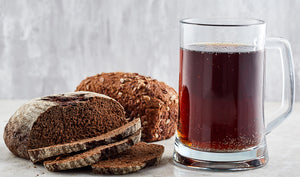
History
Gose (pronounced "goes-uh") is a German beer that some believe dates back to the 11th Century. While the date of origin is often debated, gose is one of German's most historic beers. Gose was first brewed in the German town of Goslar where the ground was found to have copper, zinc and salt deposits. It is believed these minerals were also in the ground water and contributed to gose's salty taste.
Gose was originally spontaneously fermented, and it wasn't until the late 1800s when yeast began being used. This beer style differs from other traditional German beers as it was transferred to long neck bottles but not sealed with a cap or cork. Instead, brewers plugged the top with yeast which led to a secondary fermentation in the bottle and the formation of a "yeast cork".
Gose became popular outside of Goslar, most notably in Leipzig where Gosenschänken (gose taverns) began opening. However, during the Second World War gose breweries began closing, the last shutting its doors in 1945. Gose temporarily disappeared before a single brewery revival in 1949, and disappeared again in the 1960s.
Today, gose is seeing a resurgence not just in Germany but around the world. A small number of German breweries still producing traditional gose, while craft breweries in North American are putting a modern touch on the style. This salty, tart, refreshing beer is seeing a comeback unlike any other historical beer.
Profile
Gose is unfiltered with a medium-yellow to gold colour, with a low ABV between 4.2 - 4.8%. With its high carbonation, gose has a rising and long lasting head. The addition of coriander in a traditional gose gives it aromas of lemon that compliment the malty and yeasty notes. Gose is sour and salty on the pallet with very faint bitterness from hops. High carbonation gives the gose a light and refreshing mouthfeel.
Serving
Gose is best served in a stange glass around 40º F (4.5º C). The glassware and serving temperature help bring out the tartness and saltiness of the beer. Higher temperatures will make the acidity more apparent.
Food Pairing
With it's light profile and saltiness, gose is perfect for pairing with shellfish and other lighter fare like salads. Gose is also the perfect companion for a cheese board.



Brewing Tips
- Grain Bill: The grain bill for a traditional gose should be 60% wheat malt* and 40% pilsner malt. Some brewers will add a small amount of flaked oats to add mouthfeel, but it is not necessary. *Remember to add rice hulls to prevent a stuck sparge.
- Souring: A gose is not a gose without a tart, sour taste. There are several ways to sour your beer, some more difficult and time consuming than others. Kettle souring with lactobacillus is a great way to go if you're new to souring.
- Go Easy On The Hops: Gose is not a hop forward beer and only a very small amount of hops are used to achieve a touch of bitterness without overpowering the sourness of the beer. Using the proper hops is important. Stick to traditional German hops like Hallertau or Tettnanger.



